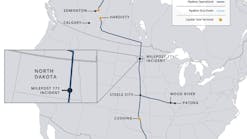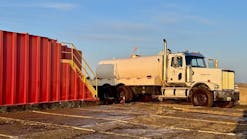Shell executives see industry benefitting from oil-spill cleanup contest
The oil industry will benefit greatly from emerging technologies unveiled during the Wendy Schmidt Oil Cleanup X Challenge in which $1.3 million was awarded to two winning contestants for demonstrating highly efficient methods to recover spilled crude oil from the ocean surface, Shell executives said.
The X Prize Foundation, a nonprofit organization, along with philanthropist Wendy Schmidt, presented a $1 million first-place award to Elastec/American Marine Oct. 11 during a ceremony in New York.
Elastec/American Marine of Carmi, Ill., and Cocoa, Fla., achieved more than three times the industry’s previous best oil recovery rate tested in controlled conditions.
The second-place winner, NOFI from Tromso, Norway, won $300,000. Despite schedule delays caused by Hurricane Irene, NOFI reached more than two times the industry’s previous best oil recovery rate.
The two winners emerged from 10 finalists selected out of more than 350 entry submissions from around the world in the competition launched in July 2010 following the April 2010 blowout of BP PLC’s Macondo well (OGJ Online, Sept. 14, 2011).
The blowout triggered an explosion-fire on Transocean Ltd.’s Deepwater Horizon semisubmersible off Louisiana that resulted in a massive oil spill in the Gulf of Mexico.
The finalist teams demonstrated their cleanup systems during rigorous testing at Ohmsett oil spill response and research in Leonardo, NJ. Ohmsett is an oil spill response and research test center owned by the US government.
Technologies tested
Each finalist had a week to demonstrate their individual technology using Ohmsett, the largest outdoor saltwater wave and tow facility in North America, said Peter K. Velez, global emergency response manager for Shell International Exploration & Production.
Velez was one of eight judges. Other judges included representatives from the National Oceanic and Atmospheric Administration, a retired US Coast Guard oil spill response specialist, and the emergency oil spill response coordinator at the US Bureau of Ocean Energy Management, Regulation, and Enforcement.
Shell was the only industry participant and was a supporting partner to the competition. As supporting partner, Shell provided the funding to lease Ohmsett and provided the oil, Velez said.
On behalf of Shell, Velez also assisted with technical, operational, and scientific components of the competition. He noted the competition enabled the 10 finalists to test their emerging technologies on a scale that they would not have been able to do otherwise.
David Lawrence, executive vice-president of exploration for Shell Upstream Americas, told OGJ that all of the technologies tested from the 10 finalists could improve oil spill response efforts.
Velez said the 10 finalists learned from their test results and developed their technology much faster than they would have done without the competition.
The next steps will involve more testing efforts and refinements of the technology, said Lawrence, who believes the technologies will be further developed and eventually commercialized.
“I was really encouraged by what I saw in the contest, Lawrence said. “New technologies can help improve our environmental performance.”
He said the competition provided innovations important to industry, oil spill response organizations, and the USCG and BOEMRE.
“These technologies will be deployed as soon as possible,” Lawrence said. “You can use aspects of these in many different places,” such as deep water, shallow water, and Arctic regions.
Boosting oil recovery efficiency
The winning teams were required to demonstrate the ability to recover oil on a sea-water surface at an oil recovery rate (ORR) above 2,500 gpm and an oil recovery efficiency (ORE) of greater than 70% oil-to-water ratio.
Elastec/American Marine, a privately held company that manufactures oil spill equipment, demonstrated an average ORR of 4,670 gpm and an average ORE of 89.5%.
NOFI demonstrated an average ORR of 2,712 gpm and an average ORE of 83%. NOFI develops and produces boom technologies and has a range of products that cover oil spill control.
The tests were done at the 2.6 million gal tank run by the US Department of the Interior and located on the high-security Naval Weapons Station Earle.
During the awards ceremony, Elastec team leader Don Johnson said it was not conceivable for a skimmer to achieve more than 2,500 gpm ORR before the Macondo oil spill. His company developed a system that involves four rows of giant grooved discs to recover spilled oil from the ocean surface.
Contact Paula Dittrick at [email protected].

Paula Dittrick | Senior Staff Writer
Paula Dittrick has covered oil and gas from Houston for more than 20 years. Starting in May 2007, she developed a health, safety, and environment beat for Oil & Gas Journal. Dittrick is familiar with the industry’s financial aspects. She also monitors issues associated with carbon sequestration and renewable energy.
Dittrick joined OGJ in February 2001. Previously, she worked for Dow Jones and United Press International. She began writing about oil and gas as UPI’s West Texas bureau chief during the 1980s. She earned a Bachelor’s of Science degree in journalism from the University of Nebraska in 1974.

